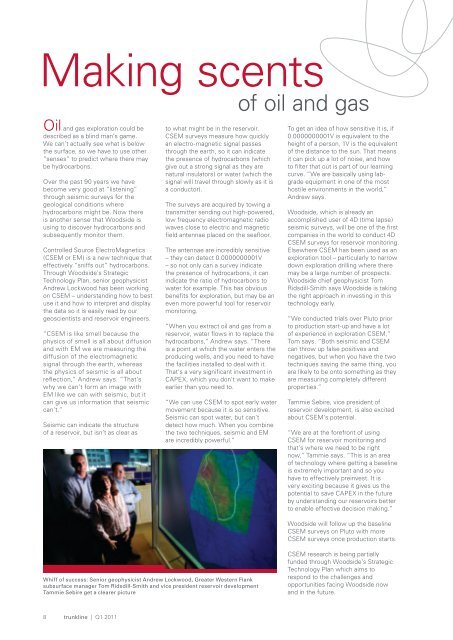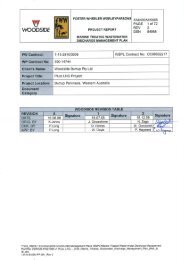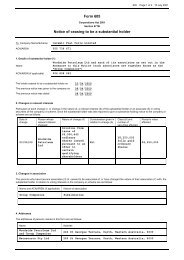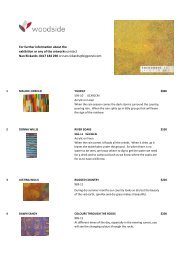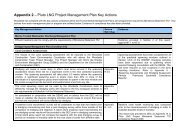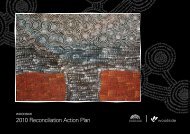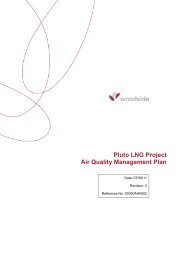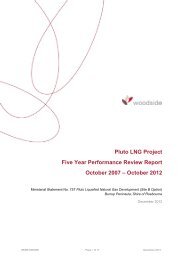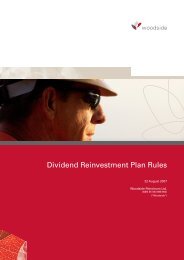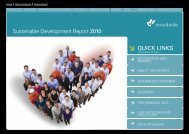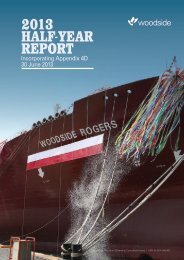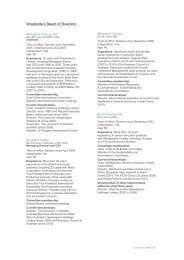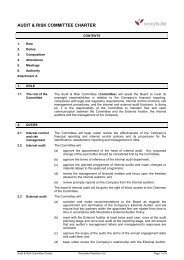trunkline - Woodside
trunkline - Woodside
trunkline - Woodside
You also want an ePaper? Increase the reach of your titles
YUMPU automatically turns print PDFs into web optimized ePapers that Google loves.
Making scents<br />
Oil and gas exploration could be<br />
described as a blind man’s game.<br />
We can’t actually see what is below<br />
the surface, so we have to use other<br />
“senses” to predict where there may<br />
be hydrocarbons.<br />
Over the past 90 years we have<br />
become very good at “listening”<br />
through seismic surveys for the<br />
geological conditions where<br />
hydrocarbons might be. Now there<br />
is another sense that <strong>Woodside</strong> is<br />
using to discover hydrocarbons and<br />
subsequently monitor them.<br />
Controlled Source ElectroMagnetics<br />
(CSEM or EM) is a new technique that<br />
effectively “sniffs out” hydrocarbons.<br />
Through <strong>Woodside</strong>’s Strategic<br />
Technology Plan, senior geophysicist<br />
Andrew Lockwood has been working<br />
on CSEM – understanding how to best<br />
use it and how to interpret and display<br />
the data so it is easily read by our<br />
geoscientists and reservoir engineers.<br />
“CSEM is like smell because the<br />
physics of smell is all about diffusion<br />
and with EM we are measuring the<br />
diffusion of the electromagnetic<br />
signal through the earth, whereas<br />
the physics of seismic is all about<br />
reflection,” Andrew says. “That’s<br />
why we can’t form an image with<br />
EM like we can with seismic, but it<br />
can give us information that seismic<br />
can’t.”<br />
Seismic can indicate the structure<br />
of a reservoir, but isn’t as clear as<br />
Whiff of success: Senior geophysicist Andrew Lockwood, Greater Western Flank<br />
subsurface manager Tom Ridsdill-Smith and vice president reservoir development<br />
Tammie Sebire get a clearer picture<br />
8 <strong>trunkline</strong> | Q1 2011<br />
to what might be in the reservoir.<br />
CSEM surveys measure how quickly<br />
an electro-magnetic signal passes<br />
through the earth, so it can indicate<br />
the presence of hydrocarbons (which<br />
give out a strong signal as they are<br />
natural insulators) or water (which the<br />
signal will travel through slowly as it is<br />
a conductor).<br />
The surveys are acquired by towing a<br />
transmitter sending out high-powered,<br />
low frequency electromagnetic radio<br />
waves close to electric and magnetic<br />
field antennae placed on the seafloor.<br />
The antennae are incredibly sensitive<br />
– they can detect 0.0000000001V<br />
– so not only can a survey indicate<br />
the presence of hydrocarbons, it can<br />
indicate the ratio of hydrocarbons to<br />
water for example. This has obvious<br />
benefits for exploration, but may be an<br />
even more powerful tool for reservoir<br />
monitoring.<br />
“When you extract oil and gas from a<br />
reservoir, water flows in to replace the<br />
hydrocarbons,” Andrew says. “There<br />
is a point at which the water enters the<br />
producing wells, and you need to have<br />
the facilities installed to deal with it.<br />
That’s a very significant investment in<br />
CAPEX, which you don’t want to make<br />
earlier than you need to.<br />
“We can use CSEM to spot early water<br />
movement because it is so sensitive.<br />
Seismic can spot water, but can’t<br />
detect how much. When you combine<br />
the two techniques, seismic and EM<br />
are incredibly powerful.”<br />
of oil and gas<br />
To get an idea of how sensitive it is, if<br />
0.0000000001V is equivalent to the<br />
height of a person, 1V is the equivalent<br />
of the distance to the sun. That means<br />
it can pick up a lot of noise, and how<br />
to filter that out is part of our learning<br />
curve. “We are basically using labgrade<br />
equipment in one of the most<br />
hostile environments in the world,”<br />
Andrew says.<br />
<strong>Woodside</strong>, which is already an<br />
accomplished user of 4D (time lapse)<br />
seismic surveys, will be one of the first<br />
companies in the world to conduct 4D<br />
CSEM surveys for reservoir monitoring.<br />
Elsewhere CSEM has been used as an<br />
exploration tool – particularly to narrow<br />
down exploration drilling where there<br />
may be a large number of prospects.<br />
<strong>Woodside</strong> chief geophysicist Tom<br />
Ridsdill-Smith says <strong>Woodside</strong> is taking<br />
the right approach in investing in this<br />
technology early.<br />
“We conducted trials over Pluto prior<br />
to production start-up and have a lot<br />
of experience in exploration CSEM,”<br />
Tom says. “Both seismic and CSEM<br />
can throw up false positives and<br />
negatives, but when you have the two<br />
techniques saying the same thing, you<br />
are likely to be onto something as they<br />
are measuring completely different<br />
properties.”<br />
Tammie Sebire, vice president of<br />
reservoir development, is also excited<br />
about CSEM’s potential.<br />
“We are at the forefront of using<br />
CSEM for reservoir monitoring and<br />
that’s where we need to be right<br />
now,” Tammie says. “This is an area<br />
of technology where getting a baseline<br />
is extremely important and so you<br />
have to effectively preinvest. It is<br />
very exciting because it gives us the<br />
potential to save CAPEX in the future<br />
by understanding our reservoirs better<br />
to enable effective decision making.”<br />
<strong>Woodside</strong> will follow up the baseline<br />
CSEM surveys on Pluto with more<br />
CSEM surveys once production starts.<br />
CSEM research is being partially<br />
funded through <strong>Woodside</strong>’s Strategic<br />
Technology Plan which aims to<br />
respond to the challenges and<br />
opportunities facing <strong>Woodside</strong> now<br />
and in the future.


